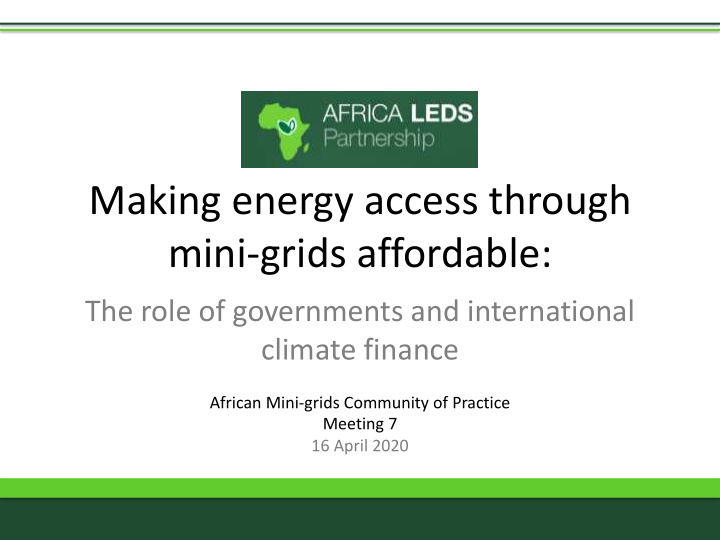



Making energy access through mini-grids affordable: The role of governments and international climate finance African Mini-grids Community of Practice Meeting 7 16 April 2020
LEDS GP Finance Working Group The LEDS GP Finance Working Group (FWG) supports developing countries in accelerating investment into low emission development through: • Peer learning & collaboration • Targeted technical resources & support • Innovative public - private partnerships
Session Overview This session will: • Explore the current mini-grid climate finance landscape in Africa • Introduce the new LEDS GP ‘Mini-grid Funding Sources in Africa” resource • Showcase an innovative financing platform- the Renewable Energy Performance Platform • Hear directly from a private sector developer, ACOB Lighting Inc, their views on the role of finance in minigrid development
Agenda Minutes Activity Speaker 0 - 3 Welcome and Overview Alexia Kelly, CEO & Co-Chair Electric Capital Management & LEDS GP FWG 3 - 15 Mini-grid Financing Landscape in Africa Alexia Kelly 15 - 25 Mini-grid Finance Deep Dive: ACOB Alexander Obiechina, CEO LIGHTING TECHNOLOGY LIMITED ACOB LIGHTING TECHNOLOGY LIMITED 25 - 40 Mini-grid Finance Deep Dive: Camco Geoff Sinclair, Managing Director Clean Energy / REPP Camco Clean Energy / REPP 40 - 50 Q & A and Wrap-up Alexia Kelly
Financial Flows & Access to Electricity ~ 840 million people worldwide still lack access to electricity 1 • International financial flows to developing countries in support of clean • and renewable energy reached $18.6 billion in 2016 2 According to the IEA Energy Outlook Report for Africa – 2019 3 : • In 2030 there are still 530 million Africans without access to energy • Despite being home to 17% of the world’s population, Africa • currently accounts for just 4% of global power supply investment Achieving reliable electricity supply would require ~ $120 • billion/year through 2040 Source: 1 sustainabledevelopment.un.org/sdg7 2 undocs.org/E/2019/68 3 iea.org/reports/africa-energy-outlook-2019
Understanding Capital Markets: the Difference Between Debt and Equity Debt Equity Capital that is borrowed for specific • Capital that is invested under • purposes and paid back at an agreed agreed terms at the corporate or interest rate over a fixed period of time project level Can be issued at the corporate or the • Usually invested in exchange for an • project level ownership (or rights to) share of a Considered “non-dilutive” because • company or project does not offer an ownership share Considered higher risk but also • Considered lower risk and usually only • higher potential reward issued once a company or project is Generally used to finance early • cash flow positive/profitable stage/higher risk investments Low Risk High Risk
Understanding Capital Markets: Channels for Private Investment Corporate Project • Invest at the COMPANY Invests at the PROJECT level or • project group level (e.g. Special level Purpose Vehicle established to • Both debt and equity hold a group of projects) Both debt and equity • Capital used for growth, • Capital used to finance specific productive development, • costs associated with project marketing, personnel, (equipment purchase, land equipment purchases, acquisition, construction, O&M, etc. etc)
Understanding Capital Markets: Channels for Private Investment 95% of the microgrid market in Stage 6 Operating Stage 5 Africa falls into these categories profitably at INVESTMENT AMOUNT Business scale Stage 4 established Can start Business Generating Stage 3 acquiring other Shouldn’t be a problem for you to move in on Shouldn’t be a problem for you to move in on established sustainable Product testing companies or Generating profit Stage 2 Saturday and be there on Friday. Saturday and be there on Friday. Operations looking at Initial revenue Stage 1 Ready to expand begin Product design/ Public Offering But pre-profit Idea Stage business/enter Development Limited cash (IPO) Product design/ new markets flow Pre-cash flow Development Early Stage Growth Stage Mezzanine Stage Pre Seed Start Up Seed Pilot Lower Risk Higher Risk
Understanding Capital Markets: Microgrid Investment Ecosystem $10 M+ DFIs/MDBs/Institutional Investors $3M-$10M Corporate Strategic Equity $500K-$3M $150-$500K Local Financial Institutions Friends and Angel $50-350K Family Offices/Impact Investors Family Grant Venture Capital Mezzanine Stage Seed Pilot Start Up Early Stage Pre-Seed Growth Stage
What Flavor of Capital? Mini-grid Funding Sources in Africa: Most Prevalent Types of Funding Institutions Type Definition Bank – Financial Institution An institution licensed to receive deposits and make loans. Family Office Full-service private wealth management services, and typically offer a total outsourced solution to managing the financial and investment side of an affluent individual or family. Private Equity Alternative investment class that consists of capital that is not listed on a public exchange. It is composed of funds and investors that directly invest in private companies or that engage in buyouts of public companies, resulting in the delisting of public equity. Multilateral Development Bank International financial institution chartered by two or more countries for the purpose of encouraging economic development in poorer countries. MDBs do not seek to maximize profits for their shareholders and often lend at low or no interest of offer grants to fund projects.
Mini-grid Funding Sources in Africa This mini-grid finance resource toolkit looks at existing investors / sources of finance, funding, and risk mitigation programs that either are or could be targeted at mini-grids. You can access this resource on the Electric Capital Management and the LEDS GP AfLP website.
Mini-grid Finance Deep Dive ACOB LIGHTING TECHNOLOGY LIMITED Alexander Obiechina, CEO Camco Clean Energy / REPP Geoff Sinclair, Managing Director
Q & A from the Audience Wrap-up and Next Steps Alexia Kelly, alexia@electric.capital
Recommend
More recommend